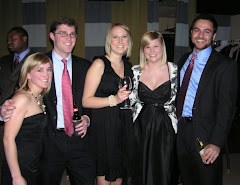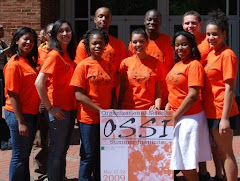Thursday, August 20, 2009
Outcomes from Collaboration: The Better Ideas Group
Given its interdisciplinary focus, the Organizational Science program naturally engenders conversations and research projects that bridge disciplinary traditions. And an early example of this type of collaboration is the Better Ideas Group (BIG), which has launched a number of promising studies.
The group started in August 2007, when a number of faculty members and students began discussing potential collaborative research ideas that centered on the topic of meetings in organizations. Those initial conversations sparked a research team that eventually included eight members: Brett Agypt, Joe Allen, Ashley Andrew, Ben Baran, Dr. Steven Rogelberg, Dr. Beth Rubin, Dr. Cliff Scott, and Dr. Linda Shanock. The discussions and projects that resulted from this collaborative effort illustrate the potential of collaborative work spanning the disciplines of Communication Studies, Industrial/Organizational Psychology, and Sociology. Specifically, three projects initiated by this group are moving forward in the publication process after data collection from hundreds of working adults.
 First, Baran and Shanock collected data from more than 350 respondents on meetings-related topics such as the role of supervisors, justice perceptions, meeting practices, perceived organizational support, and the degree of formalization and centralization perceived within respondents' organizations. The first manuscript reporting results from these data, titled "When Supervisors Lead Meetings: Relationships with Leader-Member Exchange, Perceived Organizational Support, and Meeting Citizenship Behaviors," functioned as Baran's pre-doctoral project an
First, Baran and Shanock collected data from more than 350 respondents on meetings-related topics such as the role of supervisors, justice perceptions, meeting practices, perceived organizational support, and the degree of formalization and centralization perceived within respondents' organizations. The first manuscript reporting results from these data, titled "When Supervisors Lead Meetings: Relationships with Leader-Member Exchange, Perceived Organizational Support, and Meeting Citizenship Behaviors," functioned as Baran's pre-doctoral project an d industrial/organizational psychology master's thesis. Fellow BIG members Rogelberg and Scott served on Baran’s pre-doctoral project committee, and Shanock presented a version of the paper at the International Communication Association (ICA) conference (in Baran’s absence). Shanock is spearheading work on the second manuscript based upon this study, which will investigate both structural and relational influences on meeting behaviors, effectiveness and burnout. Plans include potential conference presentations and submitting the manuscript for publication during the upcoming academic year.
d industrial/organizational psychology master's thesis. Fellow BIG members Rogelberg and Scott served on Baran’s pre-doctoral project committee, and Shanock presented a version of the paper at the International Communication Association (ICA) conference (in Baran’s absence). Shanock is spearheading work on the second manuscript based upon this study, which will investigate both structural and relational influences on meeting behaviors, effectiveness and burnout. Plans include potential conference presentations and submitting the manuscript for publication during the upcoming academic year. Second, Agypt and Rubin focused on the temporal aspects related to meetings in organizations and have presented their results
Second, Agypt and Rubin focused on the temporal aspects related to meetings in organizations and have presented their results from their data collection at meetings of both the ICA and the Southern Sociological Society. The data also served as the basis of Agypt’s pre-doctoral project. They plan to use these data as a pilot study for a grant proposal and as a springboard for an in-depth analysis of a Fortune 500 company to which they have gained access.
from their data collection at meetings of both the ICA and the Southern Sociological Society. The data also served as the basis of Agypt’s pre-doctoral project. They plan to use these data as a pilot study for a grant proposal and as a springboard for an in-depth analysis of a Fortune 500 company to which they have gained access. Third, Allen and Andrew collected data related to perceptions of organizational support, power distance, and emotion regulation in meetings. This project launched approximately six months after the other BIG surveys, which facilitated collecti
Third, Allen and Andrew collected data related to perceptions of organizational support, power distance, and emotion regulation in meetings. This project launched approximately six months after the other BIG surveys, which facilitated collecti ng of time-lagged data for the other two projects. Allen and Andrew’s first manuscript from these data focuses on perceived organizational support as a moderator of the relationship between power distance and emotion regulation in meetings. This paper will be submitted for potential presentation at the 2010 annual meeting of the Society for Industrial and Organizational Psychology.
ng of time-lagged data for the other two projects. Allen and Andrew’s first manuscript from these data focuses on perceived organizational support as a moderator of the relationship between power distance and emotion regulation in meetings. This paper will be submitted for potential presentation at the 2010 annual meeting of the Society for Industrial and Organizational Psychology.
In addition to these projects, other BIG members’ spear-headed related research endeavors. For example, Scott assembled, submitted, 
 an expert on meetings at work, research mentor, and administrator, Rogelberg provides ongoing support to BIG members, including his service on pre-doctoral project committees, attending the ICA conference, and securing financial support for data collection.
an expert on meetings at work, research mentor, and administrator, Rogelberg provides ongoing support to BIG members, including his service on pre-doctoral project committees, attending the ICA conference, and securing financial support for data collection.
Clearly, the collaborative energy associated with BIG members continues to pay off in the form of conference presentations and publishable manuscripts. And other groups like BIG exist, highlighting the remarkable interdisciplinary nature of research within the Organizational Science program. With these types of efforts underway, faculty members and students alike are building a culture of cooperation well poised for both learning and the production of meaningful research.











No comments:
Post a Comment